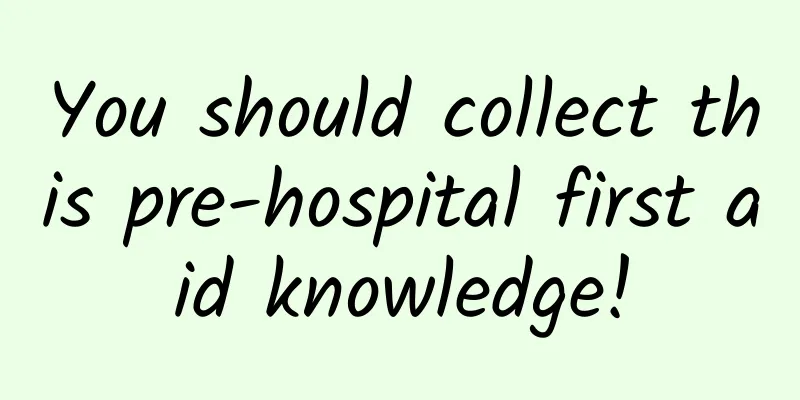You should collect this pre-hospital first aid knowledge!

|
Pre-hospital emergency care is an important indicator of the hospital's emergency treatment system and an effective way to ensure that patients receive the best rehabilitation treatment. In a sense, pre-hospital emergency care is a very critical medical behavior and a responsible behavior for seriously injured patients. In recent years, 120 is one of the main means of emergency treatment in hospitals. Its development and improvement have made it a key link in the emergency treatment system and the main body of the entire emergency system. So what else do we not know about pre-hospital emergency care? Next, I will introduce them to you one by one! The picture comes from the Internet 1. What is pre-hospital emergency care? In the past few years, the outbreak of "new crown" has occurred again and again, making us realize the hardships of life and the preciousness of life. Therefore, cherish your life in the working and living environment! The arrival of the Spring Festival has cast a thin white curtain over the whole world. Many people go home or travel on the road. There will always be some emergencies, such as injuries, such as car accidents, so at this juncture, we must learn some first aid skills, which may also be able to give ourselves a life and a chance to survive! Having said so much, what exactly is pre-hospital first aid? How should we face it? Pre-hospital first aid is the beginning of the entire first aid process and an important part. Learning basic pre-hospital first aid will greatly improve the success rate of subsequent rescue. The picture comes from the Internet "Pre-hospital emergency care" refers to the period from the time the first rescuer arrives at the scene after the patient is found and takes some necessary treatment measures, to the time when the ambulance arrives at the scene to perform emergency treatment and send the patient to the hospital emergency room. What is the significance of pre-hospital emergency care? The picture comes from the Internet (1) At the scene of the accident, the "first witness" implements effective initial emergency rescue measures for the injured to save lives and reduce disability and pain. (2) For ordinary people, it is very likely that they will be the first discoverer or rescuer. Therefore, it is also necessary to understand the concept of pre-hospital emergency care and some basic treatment principles. At work, we must strictly follow the operating instructions, which includes positioning and placing first aid supplies, keeping them by designated personnel, distributing them in quantity, regularly disinfecting them, checking them in time, replenishing them in time, and maintaining them in time. At the same time, we must establish a rigorous work style, which is mainly reflected in ensuring that various rescue items and equipment are on standby, rushing to the scene as soon as possible after receiving the first aid order, and quickly making a diagnosis of the patient. The picture comes from the Internet 2. In what situations does pre-hospital emergency care require? Before we talk about this issue, let’s look at a piece of news: Let’s look at a piece of news first. Some time ago, a girl ate hard candy and got her throat stuck. Her parents immediately used the Heimlich maneuver for first aid. After the first aid, the little girl was out of danger. It was so thrilling!!! Imagine if this happened again, if there was no good pre-hospital first aid, the result can be imagined! Therefore, mastering some hard-core first aid knowledge can save lives at critical moments! Next, I will introduce several common pre-hospital emergency measures. I hope they can help you. I also hope that you will never need to use them in your lifetime! (1) Fractures: In life, many fracture patients cannot go to the hospital for examination and treatment immediately. Before going to the hospital, you must do the correct first aid to help patients reduce the damage caused by fractures. First of all, most fractures have stable vital signs and are not life-threatening. However, the first principle of first aid on the spot for severe traumatic fractures is to save lives. If the heartbeat or breathing of the injured person has stopped or is about to stop, chest compression and artificial respiration should be performed immediately. For patients with severe bleeding, a tourniquet can be used to stop bleeding. Be sure to record the time of starting to use the tourniquet. The tourniquet should not be tied for more than 1 hour. If it is close to 1 hour, it should be released for about 2 minutes to prevent limb ischemia and necrosis. Secondly, in addition to stopping bleeding in a timely and appropriate manner, the wound should be bandaged with sterile gauze or clean cloth immediately to prevent further contamination of the wound. If there is a large foreign body deep in the wound, if the depth and whether there is damage to large blood vessels cannot be determined, the foreign body cannot be removed immediately and the patient should be sent to the hospital for treatment by a doctor. Finally, fractures in the joints of the limbs can be fixed with sticks, boards, splints, etc. If it is a lower limb, the affected leg can even be tied to the healthy side for fixation; for the upper limbs, the affected limb can be tied to the chest wall for fixation. The picture comes from the Internet (2) Shock: Shock is very common in our daily work. In emergency situations, first aid for shock is very important. After diagnosis, comprehensive and efficient treatment should be taken in a timely manner. Although there are many factors that cause shock, timely detection and timely treatment are the key. During rescue, pay attention to the comfortable posture and do not turn over, especially for fainted patients. Lift the patient's head 10-20° and lift both legs 20-30°. Pay attention to the patency of the airway, breathing status, blood flow in the blood vessels, and understand the oxygen content. Avoid aspiration and suffocation. Let the patient lie flat on the bed, hold the patient's jaw with one hand, and let his head tilt back as much as possible to make his breathing smooth. Pay attention to temperature changes. Maintain body temperature and keep warm. Hyperthermic infectious shock should be given physical therapy and drug treatment when necessary. After hospitalization, patients with shock must be monitored by professionals, and critically ill patients should be admitted to the intensive care unit. Conclusion Pre-hospital emergency care is also two-sided in the actual operation process. On the one hand, it plays a vital role in the treatment of patients' diseases, and can do its utmost to ensure the life and health of patients and promote their recovery. On the other hand, because pre-hospital emergency care is a new type of business, people do not have much understanding of the disease, and because the incident happened suddenly, it is a huge psychological shock to the patients' families. This leads to too many uncertain factors affecting the effect of emergency care during pre-hospital emergency care. |
Recommend
Treatment for painful vulvar itching
I believe everyone knows the importance of the ge...
Why do I always feel hungry after abortion?
With the gradual improvement of medical condition...
What's the matter with the small pimples on the vaginal opening of women?
What's the matter with the small bumps on the...
Short nipples and breastfeeding pain
Nips are quite important for breastfeeding women,...
Seven months pregnant, pain in the lower part when walking
When you are seven months pregnant, you should pa...
The five most vulnerable parts of women
Humans are born "weak" animals. Their h...
Pregnant mother nipple picture
During pregnancy, the mother's body changes g...
Why do I get chest pain when I'm angry?
Why does chest pain occur when you are angry? Som...
Why are hot dogs called hot dogs? Can hot dogs be heated in the microwave?
Hot dog is a way of eating sausage. The whole bre...
Why do we drink mutton soup during the Great Heat? How to preserve mutton soup in summer
Mutton soup tastes very delicious. Drinking mutto...
Can pregnant women have a spa?
Pregnant women can do SPA, which is a common beau...
Can I eat hotpot if I have irregular menstruation?
Whether a woman's menstruation is normal will...
How to remove milk knots
It is not easy to get pregnant. You have to carry...
Can pregnant women use Anessa sunscreen?
Can pregnant women use Anessa sunscreen? Among th...
Will I have breast pain when I'm pregnant?
When a woman just becomes pregnant, typical early...









